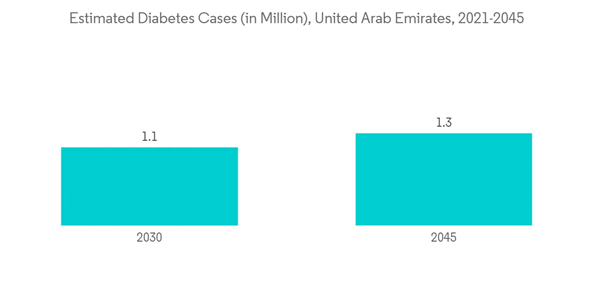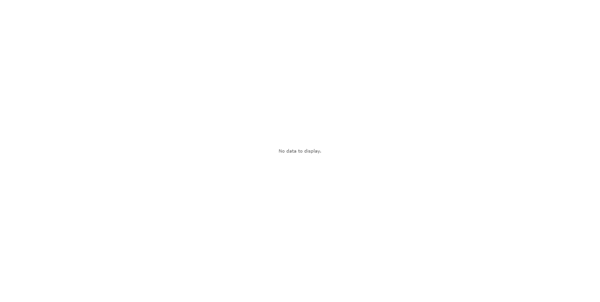COVID-19 has significantly impacted the growth of drug delivery devices in the United Arab Emirates. Due to the increased infection among the population, the demand for vaccines has increased, which has fueled the demand for drug-delivery devices in the country. For instance, from an article published in Nature Immunology in July 2021, it has been observed that in cooperation with international organizations, the Abu Dhabi Medical Devices Company delivered more than 500 million syringes and needles for COVID-19 vaccinations, which was equal to 25% of UNICEF and COVAX's projected global need for 2021. Moreover, with the released COVID-19 restrictions, resumed services and treatment procedures as well as increased patient visits, the demand for drug delivery devices for administering drugs is expected to increase over the forecast period. This, in turn, is anticipated to fuel market growth.
Certain factors that are propelling the market growth are the increased prevalence of chronic diseases, technological advancements, rising individual therapy, the growing understanding of drug metabolism among the population, and the requirement for controlled drug release.
As drug delivery devices help deliver drugs, which are beneficial for the targeted population to recover faster, there has been a growing adoption and inclination toward advanced drug delivery devices. Moreover, the increasing number of cancers, respiratory diseases, and diabetic patients across the world may promote the adoption of drug-delivery devices and drive the overall market. For instance, as per the GLOBOCAN 2020 factsheet, 4,807 new cancer cases were reported in 2020 in the United Arab Emirates, while the five-year prevalence (all ages) was 14,816. In addition, as per the same source, 1,030 new cases of breast cancer, 405 of thyroid cancer, 334 colon cancer, 270 prostate cancer, 226 lung cancer, and 164 rectum cancer were reported in 2020 in the United Arab Emirates. Also, the highest prevalence of cancer was found in women (2,652) compared to men (2,155). This growing burden of cancer increases the adoption of drug-delivery devices, which is expected to contribute significantly to market growth over the forecast period.
In addition, according to the 2022 statistics published by the IDF, in the United Arab Emirates, 0.99 million people were living with diabetes in 2021. In addition, as per the same source, this number is projected to reach 1.17 million by 2030 and 1.32 million by 2045. Thus, the increase in the number of people suffering from diabetes is expected to fuel the demand for novel drug delivery devices, which, in turn, is anticipated to propel market growth over the forecast period.
Similarly, according to an article published in the World Journal of Gastroenterology in July 2020, about 372,000 people were projected to develop the non-alcoholic fatty liver disease (NAFLD) in the United Arab Emirates by 2030. In addition, as per the same source, the prevalence of NAFLD was expected to rise by 87% by 2030 in the United Arab Emirates. Thus, the increase in the population suffering from NAFLD is expected to increase the demand for nanocarrier drug delivery system that delivers the drug to specific liver cell types that help in improving efficacy and reducing side effects. This is anticipated to fuel the growth of drug delivery devices in the country over the forecast period.
Furthermore, as per a meta-analysis study published in December 2021, it has been observed that the combined prevalence of hypertension was 31% in the United Arab Emirates. In addition, as per the same source, the prevalence of hypertension was highest in Dubai (37%) than in the Abu Dhabi region (29%). Thus, the elevated blood pressure in the population causes the left ventricle to thicken, which increases the risk of heart attack, and cardiac failure. This is expected to increase the demand for conventional and advanced drug delivery devices, thereby propelling market growth.
However, the risk of needlestick injuries is likely to hinder the market growth over the forecast period.
United Arab Emirates Drug Delivery Devices Market Trends
Oral Segment Expects to Register a High CAGR in the United Arab Emirates Drug Delivery Devices Market Over the Forecast Period
The oral segment is expected to witness significant growth in the United Arab Emirates delivery devices market over the forecast period. Oral-release drug delivery systems have received extensive attention owing to their flexibility, reduced dosing frequency, and better patient compliance.The factors attributing to the growth of the market are the rising prevalence of chronic disease and the easy administration of drugs. For instance, in an article published in September 2021, researchers in the United Arab Emirates showed that combining polymers can significantly alter how the medication release pattern is controlled and prolonged. In addition, it has been observed that the matrix system comprising poloxamer188, hydroxypropyl methylcellulose, and stearyl alcohol is an effective one for regulating the release of diltiazem hydrochloride, which helps in treating hypertension and atrial fibrillation. This research is expected to increase the development of oral drug delivery devices for administering exact doses of drugs to patients suffering from hypertension and cardiovascular-related conditions, which is anticipated to fuel market growth.
Therefore, owing to the abovementioned factors, the studied segment is predicted to witness growth over the forecast period.
Injectable Segment is Expected to Have the Significant Market Share Over the Forecast Period
The injectable drugs segment is expected to grow over the forecast period owing to the factors such as the increasing number of chronic diseases, like cardiovascular disorders, diabetes, and cancer, and the growing demand for injectable drugs in the country.In addition, the rising adult and aging population in the country are more prone to develop chronic diseases, which further raises the demand for effective drugs that can be administered safely and easily. This is anticipated to fuel market growth. For instance, according to 2022 statistics published by the UNPF, 83% of the population living in the United Arab Emirates is aged between 15 and 64 years, and 2% of the population is aged 65 and above.
The increasing drug approvals and company activities in developing injectable drugs are also contributing to the market growth. For instance, in October 2022, Hikma Pharmaceuticals launched Succinylcholine Chloride Injection in prefilled syringe (PFS) form, which is used for general anesthesia, to facilitate tracheal intubation, and to provide muscle relaxation during surgery or mechanical ventilation.
Therefore, owing to the factors mentioned above, the studied segment is predicted to witness growth over the forecast period.
United Arab Emirates Drug Delivery Devices Industry Overview
The drug delivery devices market is moderately competitive and consists of several major players. Some of the players in the United Arab Emirates drug delivery devices market are Becton, Dickinson and Company, GlaxoSmithKline PLC, Merck KGaA, and Bayer AG.Additional Benefits:
- The market estimate (ME) sheet in Excel format
- 3 months of analyst support
This product will be delivered within 2 business days.
Table of Contents
Companies Mentioned (Partial List)
A selection of companies mentioned in this report includes, but is not limited to:
- AstraZeneca PLC
- Becton, Dickinson and Company
- GlaxoSmithKline PLC
- Merck KGaA
- Bayerc AG
- Johnson and Johnson
- Pfizer Inc.
- F Hoffmann-La Roche Ltd
- Eli Lilly and Company










